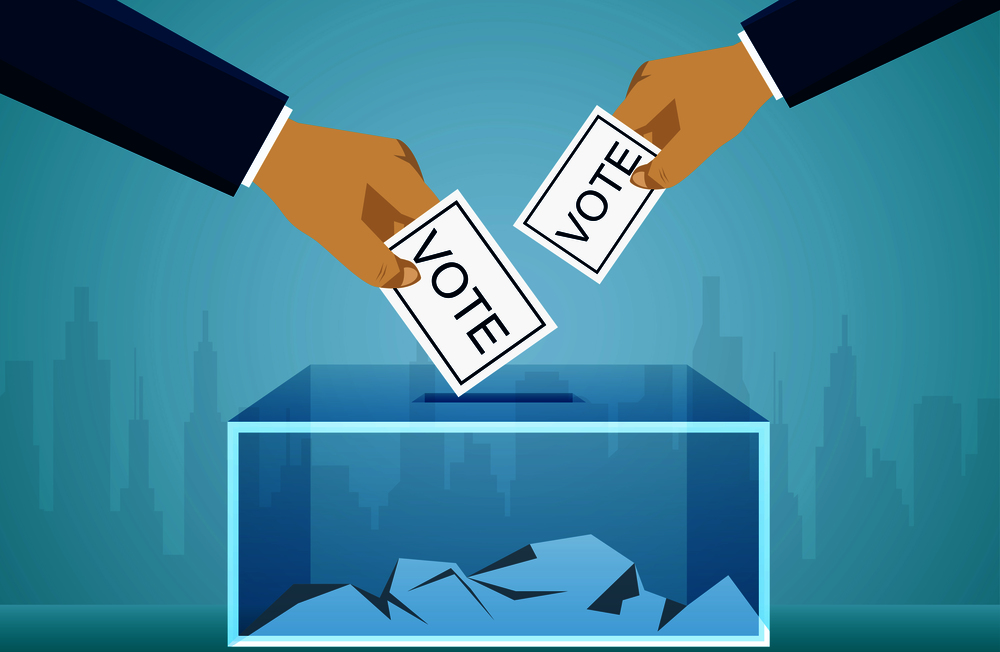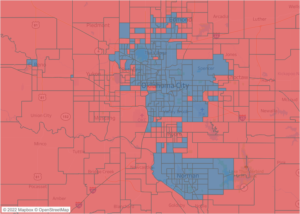Last week, we released our “Birds-Eye View” of the midterm elections, listing results of some key races and noting some interesting trends across the country. Now, with ballots fully counted and results being finalized in national races, we’re ready for a deep dive into the midterm election, starting with the question:
What does this mean for all of us?
It’s easy to get caught up on campaigns, party lines, and candidates. While usually underestimated and ignored, midterm elections are a key part of our democratic process that goes beyond the “winners” on the ballot. Also decided are ballot initiatives and questions that often reform state constitutions and influence decisions that exceed any term limits.
From voter turnout and representation, Congressional control, and money, to historic firsts this midterm exposed new developments for all parties involved.
Oklahoma and Beyond Voter Dynamics
Here in our home, the state continued to bleed red, but post-election results show that larger city centers are voting Democrat. While Gov. Stitt won 74 out of 77 counties in the state, Hofmeister took Tulsa, Oklahoma, and Cleveland County. Digging deeper, she also won several typically Republican areas in Lawton, Ada, and Stillwater to name a few, while Gov. Stitt also took some areas around Tulsa and Oklahoma City. Although pockets of blue are changing, a large percentage of voters remain staunchly with their party, as an alarming 40% of people voted straight-party, with 70% for Republicans and only 29% Democrat. This means that half the votes for Gov. Stitt’s re-election were achieved through straight-ticket, and a similar result for Ryan Walters, state Superintendent-elect. Oklahoma is one of only six states to retain such a system for all partisan elections, which might be a case to evaluate.
Results show that while this was the lowest turnout for a midterm election, it was the highest for a gubernatorial re-election in 30 years. Additionally, compared to results in the presidential election in 2020, there has been a statewide shift to the left. Across the state in almost all counties, the margin of Republican votes for Stitt was much lower than the votes for Trump in the 2020 elections.
Voter turnout nationwide also defied expectations in terms of party representation and voting habits. Typically, the incumbent leading party fares poorly in midterms due to dissatisfaction with the president and attitudes post-election. However, youth, women, and Latino voters all showed up in greater numbers and played a huge role to abate the predicted “red wave” across the country. Young voters (18-29) had a 27% voter turnout rate, the highest in 30 years, and voted primarily Democrat. Latino voters under 30 overwhelmingly voted Democrat, 68%, with only 43% even identifying with the party. Nationwide, Native Americans voted more on Democratic lines. Overall, 44% report being registered Democrat, 32% Republican, and 23% Independent, and for 22%. Of those registered Democrat, an impressive 98% voted as such. However, even with a marked increase in interest state-wide with rallies and initiatives, the community overall remains underserved by candidates and governments.
However, racial and ethnic groups are not monoliths, and most age and geographical demographics vary for voting preferences. Women, making up 52% of the population, saw a record number of voter registrations following the Dobbs decision and following this, a record number of early voters this midterm. Abortion rights were a distinct issue, specifically affecting this voting group, and the results showed that Kansas was not an anomaly in rejecting extreme anti-choice measures, as women were activated across the country during the midterms.
Cross-Country Competition (or lack of)
Although this midterm saw certain demographics re-invigorated at the polls, overall voter apathy seems to stretch beyond the ballot box, as many states had candidates running unopposed. A recent study by the Institute for Research and Education on Human Rights identified a sample group of 875 state lawmakers who are publicly aligned with far-right groups on their social media platforms. This past midterm election had 575 people seeking re-election, and 190 of these candidates ran completely unopposed. Overall, 97% of these fringe far-right candidates won back their seats. However, regardless of party lines and membership, this is not an uncommon trend.
In New York, 40 elected officials and candidates also saw zero competition. Massachusetts serves as another example. For this midterm 2022, every seat in the 200-seat state Legislature was up for voters to choose. Overall, nearly two-thirds went uncontested.
Many swing states went blue, and although some still made it in, several of the Trump-endorsed, QAnon candidates did not take seats as expected. Dr. Mehmet Oz lost to John Fetterman in Pennsylvania, and the governor candidate Douglas Mastriano also lost to Democrat Josh Shapiro. This suggests that Trump’s support may not be as helpful to Republican candidates as previously anticipated, and may even signal a further split within the Republican party.
In Georgia, a Senate race remains undecided as Raphael Warnock (D) and Herschel Walker (R) will head to a run-off in December. Alaska also heads to a run-off election with two Republican candidates on the ballot via ranked choice voting. A handful of House races remain to be called as well, with mail-in ballots still being counted. Recent reports show that Republicans will take a slim majority in the House with 218 seats and Democrats having 210. Republican minority leader Kevin McCarthy will seek to replace Nancy Pelosi as Speaker of the House. With Senate headed towards Democratic control, a split house sets up for a challenging two year for President Biden.
Another major win for the GOP was the incumbent governor of Florida, Ron DeSantis, maintaining his seat by 20 points. His re-election gains more traction in the party, as Trump continues to alienate many, and DeSantis grows as the “heir apparent”. Trump announced this week that he would be running in 2024; DeSantis is expected to make a similar announcement soon.
Overall, this midterm saw record-breaking finance spending. The total spending is estimated to exceed $16.7 billion, with spending split between federal candidates and political action committees and the state candidates, party committees and ballot initiatives. The previous record lay with the 2018 midterm at over $5.7 billion. This midterm saw the top spenders between two Republican-aligned PACs, the Senate Leadership Fund and the Congressional Leadership Fund, with both spending over $205.4 million and $188.1 million respectively. The most expensive races were also the two of the most competitive, the Georgia Senate Race and Pennsylvania senate race, costing over $140 million dollars each according to nonpartisan research group OpenSecrets.
(Finally) First’s
The elections covered many groundbreaking firsts with new leaders. In Massachusetts, Maura Healy (D) will be the state’s first elected female governor and the first out lesbian governor in the United States. Massachusetts and Arkansas will also be the first states to have concurrent female governors and lieutenant governors serving. New York also welcomes its first female governor with Kathy Hochul (D).
In Florida, Maxwell Frost (D) becomes the youngest individual ever elected to US Congress at 25, the minimum age to run. Several other states saw first for Black men and women, Latinos and across the board Muslims saw record numbers with 83 wins across local, state, and federal elections.
Regardless of party control, this next House looks to be the youngest and most diverse ever. Current Congress has 23% of members are racial or ethnic minorities; of those, 83% are Democrat, and 17% Republican.
Ballot Bonuses
In Oklahoma, some voters’ ballots included a county question regarding a bond for Oklahoma City Public Schools (passing 62% for, $955 million in total for school improvements). Other states voted on abortion access and anti-slavery measures.
All five states that had abortion-related initiatives on their ballots received overwhelming support to maintain access to safe medical care for people needing abortions. California, Kentucky, Vermont, Montana, and Michigan all voted for various forms of protection for reproductive freedom in their constitutions.
In 2022 it may be surprising to some to see anti-slavery initiatives as part of ballot measures; however, the 13th Amendment to the Constitution permits involuntary servitude as a legal form of punishment. The current prison labor industry rakes in $11 billion annually from the labor of incarcerated people. Since 2018, several state constitutions have banned the practice of slavery and indentured servitude as punishment for crimes. This midterm, Alabama, Tennessee, Vermont and Oregon voters all supported to remove exceptions allowing for forced labor in their state constitutions.
Conclusion:
While the most expensive, and maybe the most painful for some, this midterm election saw sharp responses from candidates and voters alike. Top CEO’s donated to political parties, younger voters headed to the polls, and even more Oklahomans chose to vote early or via mail. Across the country, communities did their best to defy decades of voter repression and make their voices heard. However, many chose to stay on party lines and ignore critical issues to help states develop.
Ultimately, our democratic process showed room for growth. The effects of gerrymandering from the 2020 Census were felt across many states and were revealed in the final House results. Other systems like rank choice voting versus straight ticket voting deserve further study to evaluate voter engagement and accessibility for candidates.
With empty seats lacking contenders, many new faces made it into legislatures across the country. However, many old faces stayed unencumbered and unchallenged, providing fewer opportunities for meaningful democratic participation. With a split federal Congress, it is unlikely to see functional policy changes in the future.
However, on a state-by-state level, huge efforts were made to inspire voters from all communities. Grass-roots campaigns are essential to spark reform, and this activism has contributed to changes in state constitutions and consciousness. Democracy does not exist without the people, and it is up to us to make these changes happen by engaging in these processes. Midterms matter, and it is our duty to uphold our leaders to the standards we elected them to.




